Kastellorizo sits just two kilometers from Turkey’s coast, yet feels a world apart. It’s 116 kilometers from Rhodes, the nearest Greek island, and honestly, it feels like a secret that only a few hundred people are in on.
This tiny Dodecanese island, officially called Megisti since ancient times, covers just 9.2 square kilometers. Somehow, it manages to squeeze in more charm than islands ten times its size.
Kastellorizo delivers an authentic Greek island experience. Colorful neoclassical houses line a pristine harbor, ancient history seems to linger in every corner, and fewer than 300 residents nurture a genuine community vibe that’s nearly impossible to find on Greece’s more popular islands.
What really struck me? Kastellorizo somehow feels both incredibly remote and quietly sophisticated. Artists, filmmakers, and creative souls have transformed abandoned mansions into stylish retreats, all while keeping the authentic character alive.
There’s no nightlife scene, and you won’t find crowded beaches. But honestly, that’s part of its magic. Instead, you get peaceful beauty that lets you truly disconnect.
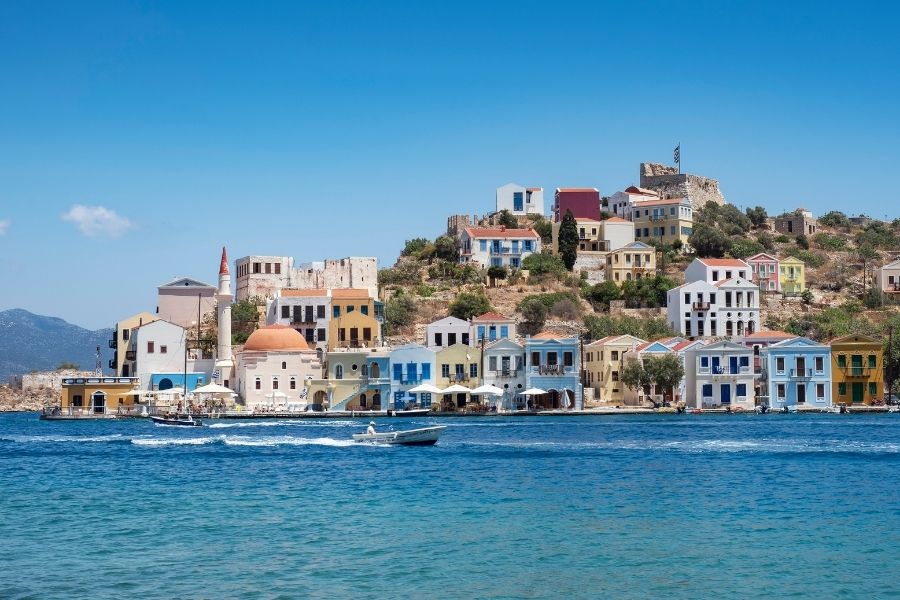
During my visit to Greece’s easternmost edge, I swam off rocky platforms instead of sandy beaches. The Blue Grotto glowed with otherworldly light, and dinner invitations from locals felt more precious than any attraction.
I wandered ancient monasteries perched on clifftops and poked into the stories behind those postcard-perfect harborfront houses. Kastellorizo showed me that sometimes the smallest places leave the biggest impressions.
Why Kastellorizo (Megisti) is a Jewel-Box Getaway
This tiny Greek island draws you in with its perfectly formed harbor and those irresistible neoclassical houses. There’s a deep cultural connection here.
Fewer than 300 residents create an atmosphere that blends privacy with genuine Greek hospitality.
Unique Charm of a Tiny Island
Kastellorizo feels like you’ve stepped into a living postcard. The harbor town stretches along a narrow waterfront strip—the locals call it the “Kordoni,” or shoelace.
Bright fishing boats bob outside tavernas. Houses painted in burgundy, baby blue, sunflower yellow, and cypress green line the water. There’s only one tarmac road, connecting the tiny airstrip to town.
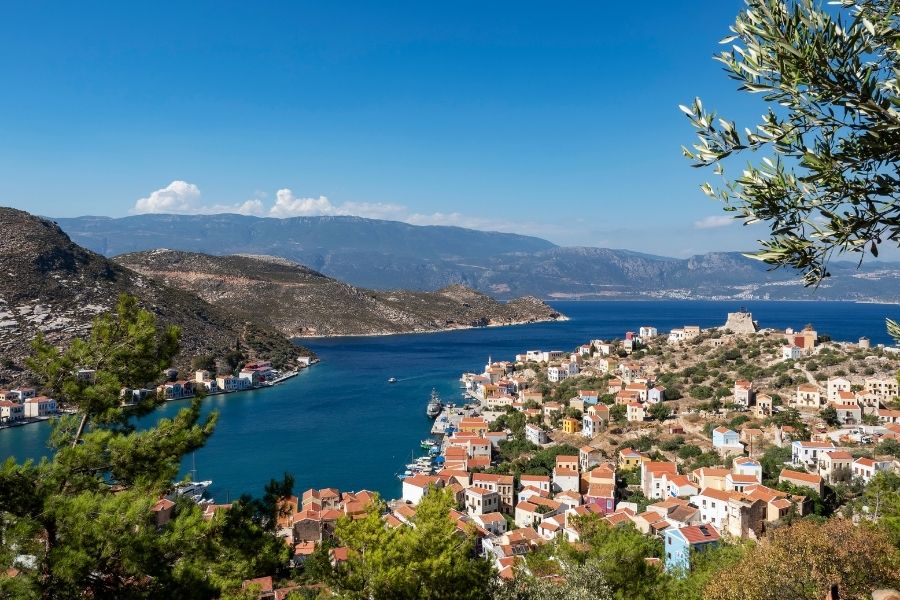
Life here operates on a human scale. The island has just one taxi driver, who also happens to be the monastery tour guide. Pretty much everything’s walkable.
What makes it special:
- No sandy beaches, but plenty of swimming spots
- Many accommodations offer direct sea access
- The Blue Grotto sea cave is only reachable when the sea is calm
- Ancient fortress ruins and Ottoman architecture blend together
Kastellorizo’s remote location, just 2 kilometers from Turkey, gives it an exotic edge. Ferry connections take some planning, which keeps the crowds away.
Warm Hospitality and Community Spirit
Locals treat visitors as extended family, not just tourists. I noticed how much residents care about preserving their island’s character while still sharing it.
Greek-Australian families who returned after WWII bombing have created a unique cultural mix. Many people speak several languages and see the world from different angles.
Community spirit shines in moments like:
- Artists and residents inviting visitors to dinner parties
- The local museum owner offering personal walking tours
- Restaurant owners handing out keys to historical sites
- Family-run tavernas serving recipes passed down for generations
The social scene centers around casual encounters, not nightlife. Conversations spark naturally at harborside cafés or during a sunset swim.
People respect privacy here. Even well-known visitors can relax, knowing nobody will bother them—a true haven for families who want real relaxation.
What Makes Kastellorizo Stand Out
This island pulls in a creative, sophisticated crowd looking for substance over spectacle. Art collectors set up residencies, and acclaimed designers have built homes here.
Every August, the Beyond Borders documentary film festival draws international filmmakers. Cultural dialogue happens naturally, not through forced entertainment.
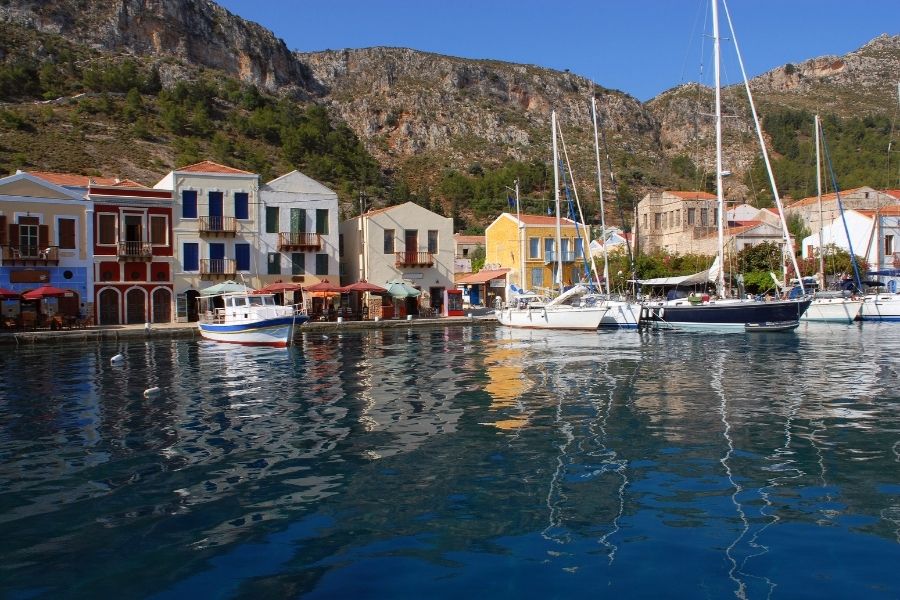
Key things that set it apart:
- Size: Smallest inhabited Dodecanese island
- Location: Greece’s easternmost point
- Access: Limited transport keeps it exclusive
- Vibe: Intellectual retreat, not a party scene
Many civilizations have left their mark here—Ancient Greeks, Ottomans, French, British, and Italians all controlled this strategic trading post.
The island nearly faded away, but careful restoration brought it back. French architect Marie Rivalant and other passionate people have transformed crumbling buildings into boutique accommodations.
Unlike the overcrowded Greek hot spots, Kastellorizo lets you escape. The pace slows down, and your biggest worry might be which swimming spot or taverna to try next.
Unveiling Kastellorizo’s Breathtaking Sights
The island’s main attractions cluster around its colorful harbor, filled with restored mansions, and the famous Blue Cave you can only reach by boat. Ancient ruins and crystal-clear swimming spots round out the picture.
Stunning Harbor and Neoclassical Houses
The harbor honestly stopped me in my tracks. Bright yellow, orange, and red houses hug the waterfront like a painted postcard.
These neoclassical mansions date back to the 1800s, when trade brought the island wealth. Locals have lovingly restored many of these grand homes.
I spent hours just wandering the port, admiring the carved window frames and ornate balconies. The architecture mixes influences—Ottoman, Italian, and classic Greek.
Some houses rise three stories, with elegant stonework on the ground floor. In late afternoon, the sun lights up the facades, making the colors pop against the blue water. That’s the time to take your best photos.
Sea captains and merchants built most of these mansions, using local stone and imported materials to show off their success.
The Blue Grotto: A Natural Wonder
To get into Greece’s largest sea cave, I had to lie flat in a tiny boat. The entrance sits so low, only skilled boat operators can safely guide you inside.
Once inside the Blue Cave, sunlight filters through an underwater opening, turning the water a surreal electric blue. Stalactites hang from the ceiling, giving the place an otherworldly vibe.
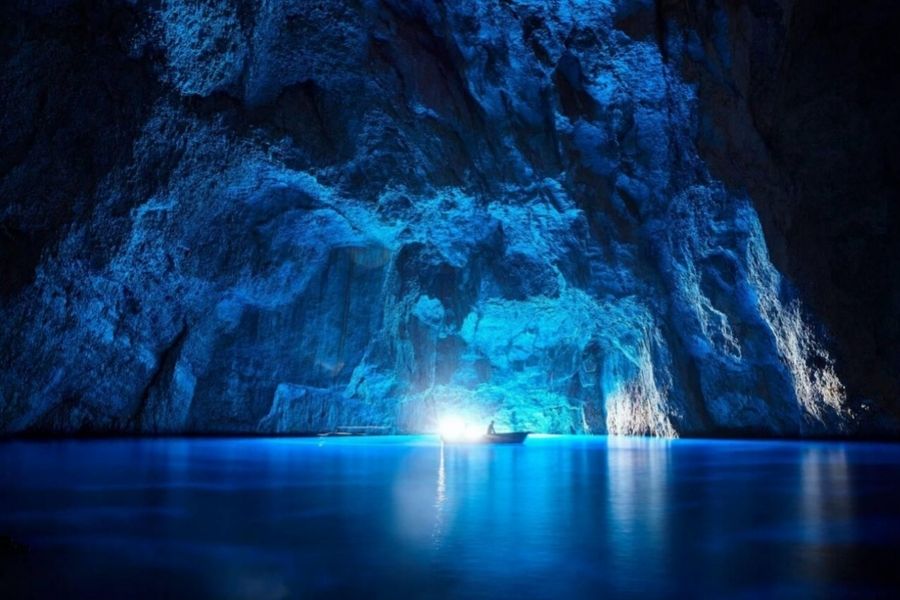
The cave stretches about 40 meters long and 25 meters wide. Some spots reach 35 meters deep. The blue glow shifts throughout the day, depending on the sun.
Boat trips cost around €15-20 per person and last about 45 minutes. Local fishermen run the best tours—they know every inch of the cave. Mornings are ideal, when the light is strongest.
Swimming inside is possible for strong swimmers, but the water stays cold year-round, about 18°C.
Historical Kastellorizo Castle
Castel Rosso sits high above the harbor, giving the island its name. The Knights of St. John built this red-stone fortress in the 14th century.
I climbed the steep path up to the ruins. The view pays off—on clear days, you can spot Cyprus in the distance, along with the Turkish coast just 2 kilometers away.
The castle once had double walls for defense against Ottoman attacks. Now, only parts of the outer walls remain. The main gate and several towers still stand.
This fortress controlled shipping routes between Europe and the Middle East, making Kastellorizo a key spot for trade and military strategy.
Entry is free and the site stays open all day. Bring water—the climb offers no shade.
Megisti Port Highlights
The port is the island’s main gathering spot. Locals and visitors meet here every evening.
Stone quays line the waterfront, offering perfect places to swim since there aren’t traditional beaches. Swimming ladders make it easy to slip into the clear water.
I often spotted large sea turtles gliding near the harbor, unfazed by swimmers. The Museum of Kastellorizo sits in a former mosque near the port, displaying artifacts from Byzantine, Ottoman, and Lycian times. Opening hours change with the seasons, so check locally.
Cafes and tavernas cluster around the port. Fresh fish lands daily from local boats. In the evening, everyone takes a volta (stroll) along the waterfront.
Mandraki offers a small sandy area near the cemetery. Families with young kids often swim here for easier access.
Experiencing Local Life and Culture
Kastellorizo’s small size creates an intimate setting where Greek island traditions thrive. The neoclassical houses frame daily life—think traditional cooking, local celebrations, and handmade crafts that echo centuries of Mediterranean heritage.
Traditional Greek Cuisine and Tavernas
Tavernas on Kastellorizo serve dishes that blend Greek flavors with Turkish touches. The local sutzukakia (spiced meatballs) really stood out for me.
Seafood rules the menus. The daily catch includes sea bream, red mullet, octopus, and—if you’re lucky—lobster pasta.
Mezedes (small plates) are perfect for sharing. Order a few and taste your way through the local specialties.
Waterfront tavernas offer the best dining views. Most places rely on family recipes passed down through generations.
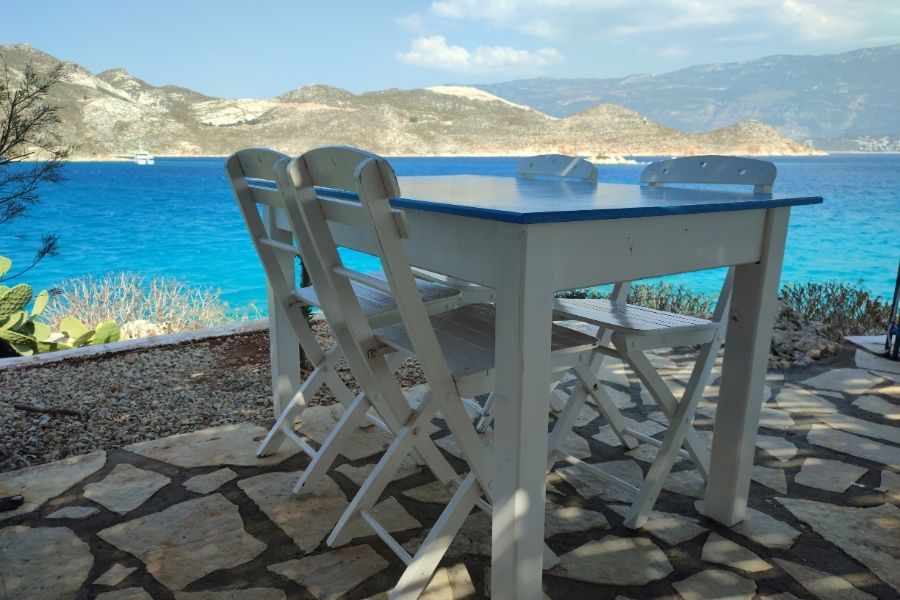
Local ingredients—capers, wild herbs, olive oil from nearby islands—show up in nearly every dish. Many restaurants even grow their own herbs in tiny gardens out back.
Festivals and Authentic Celebrations
The Feast of Agios Konstantinos in May brings everyone together. I watched as locals carried religious icons through narrow streets, with traditional music filling the air.
Easter is the biggest event of the year. The midnight service at the main church draws the whole island.
Summer festivals mean live Greek music and dancing. The harbor transforms into an outdoor dance floor.
Name days are celebrated often—these personal holidays matter more than birthdays in Greek culture.
Religious processions happen several times a year, and the whole community joins in.
Artisan Crafts and Souvenirs
Local artisans craft handmade ceramics with classic Greek patterns. I found some unique pieces in little shops near the harbor.
Worry beads (komboloi) make popular souvenirs. Craftsmen use olive wood, coral, and other materials.
Traditional textiles include embroidered tablecloths, hand-woven rugs, and decorative wall hangings.
The island’s sponge diving heritage shows up in many crafts. Natural sponges make practical souvenirs and nod to local maritime traditions.
Small jewelry shops sell pieces inspired by ancient Greek designs, often featuring motifs from nearby archaeological sites.
Local honey and preserved fruits are easy to find in the grocery stores. These edible souvenirs capture the island’s flavors.
Adventures and Relaxation on Kastellorizo
Kastellorizo’s crystal-clear waters are perfect for swimming and snorkeling. Boat trips take you to hidden caves and neighboring islets.
The island’s rocky terrain offers scenic walking paths with stunning views of both Greek and Turkish shores.
Swimming, Snorkeling, and Boating
Forget sandy beaches—Kastellorizo’s charm is swimming straight from the harbor’s stone quays. Swimming ladders dot the waterfront, making it easy to slip into the sea.
The water stays so clear, I could watch sea turtles glide past without a care. The emerald waters keep their sparkle all season.
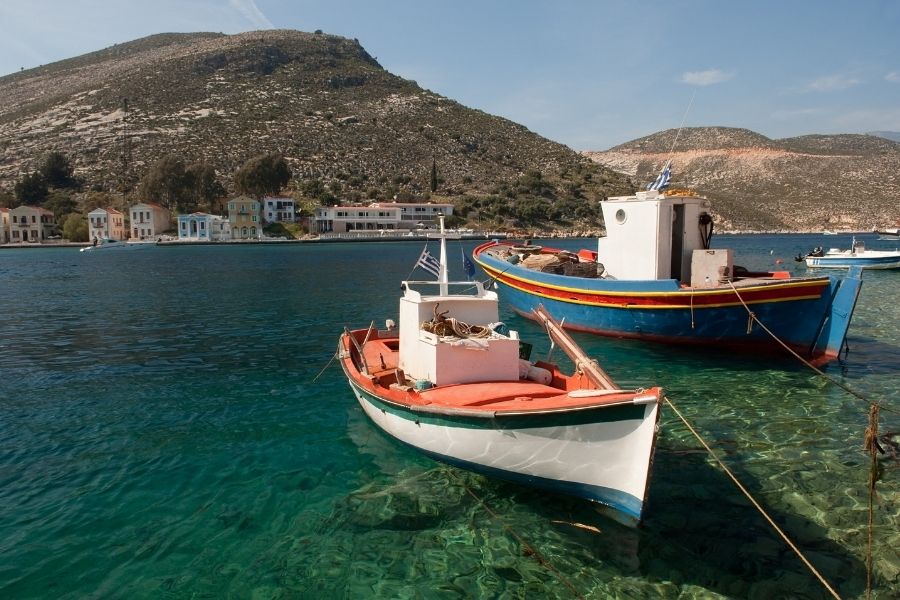
Best Swimming Spots:
- Harbor stone quays with ladders
- Mandraki’s small sandy patch (great for families)
- Rocky coves you can reach by boat
Snorkeling trips take you to Parasta and Fokiali caves, where marine life and clear visibility await. Bring your own gear—rentals are rare.
Boat rentals and sea taxis run during peak season. Small boats can reach coves and caves you’d never find on foot.
Scenic Walking Trails
Kastellorizo’s mountainous, rocky landscape naturally carves out walking paths. I found the climb up to Castel Rosso especially rewarding. This medieval fortress, built by the Knights of St. John, just kind of sits there, daring you to climb for those sweeping views.
From the top, I could spot both the Greek and Turkish coastlines—almost surreal, honestly. The fortress stands about 116 kilometers from Rhodes and barely 2 kilometers from Turkey.
A stroll along the waterfront brings you past neoclassical mansions from the 19th century. Their restored facades and ornate balconies whisper stories from the island’s more prosperous days.
If you’re craving a gentle walk, the cemetery area offers a peaceful path. It leads toward Mandraki and gives you harbor views, without making your calves scream.
Beaches and Hidden Coves
Mandraki, tucked near the cemetery, is the island’s only sandy spot. Families with little kids seem to gravitate here since the sea entry is so gentle.
Plakes lies north, where smooth marble slabs slope right into clear water. There’s zero shade, so I’d go early or late unless you’re a sun worshipper.
Honestly, since traditional beaches are rare, boats become your best friend for swimming. Most of the coastline is rocky—gorgeous to look at, tricky to get in.
I found swimming from the harbor ladders easiest for daily dips. The harbor’s sheltered waters stay much calmer than the open sea.
Day Trips to Neighboring Islets
For the best beach day, hop over to Agios Georgios islet. There’s a simple taverna and a couple of dreamy coves—perfect for just zoning out all day.
Sea taxis run regular trips to Agios Georgios in high season. The boat ride only takes about 15 minutes from the main harbor, so it’s easy.
Ro and Strogili islets are even quieter. These little uninhabited spots have pristine water and total privacy—ideal for swimming or snorkeling.
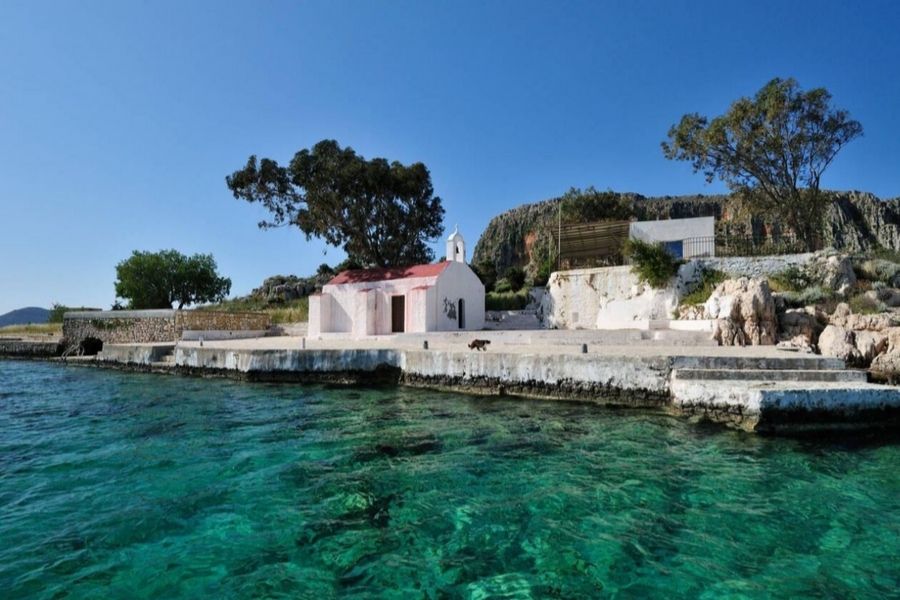
The famous Blue Cave (Galazio Spilaio) is a must. You need a boat, and yes, you have to lie flat to squeeze through the cave entrance, but once inside, sunlight turns the water an unreal shade of blue.
Boat operators usually offer half-day or full-day trips that combine a few islets and caves. You’ll get swimming stops and maybe a snack or two.
Planning Your Escape to Greece’s Easternmost Edge
Getting to this tiny island takes some planning. It’s just 2 kilometers from Turkey’s coast but well over 100 kilometers from Rhodes. Let’s talk about how to get there, where to stay, and how to make the most of your time on this peaceful edge of Greece.
How to Get to Kastellorizo
Flying is the simplest way to reach Kastellorizo. The island’s airport handles small charter flights, mostly from Rhodes. I’d suggest booking way ahead, especially in summer—seats disappear fast.
There’s also a ferry from Rhodes twice a week. The trip takes several hours and, honestly, the ferry’s usually half-empty, even when the island is buzzing. That means you can stretch out and relax.
Transport Options:
- Flight from Rhodes: Around 30 minutes, charter flights only
- Ferry from Rhodes: 4-5 hours, twice a week
- Day trips: Some tour operators in Rhodes offer day excursions
Book your tickets early, especially if you’re visiting in summer. With so few departures, missing one can really throw off your plans.
Where to Stay: Accommodation Guide
Kastellorizo’s accommodations are simple but comfortable. Most places cluster around the cheerful harbor, so you’re always close to restaurants and sights.
You’ll mostly find small guesthouses and old-school hotels. Many are family-run and happy to share local tips. Several have balconies or windows overlooking the water.
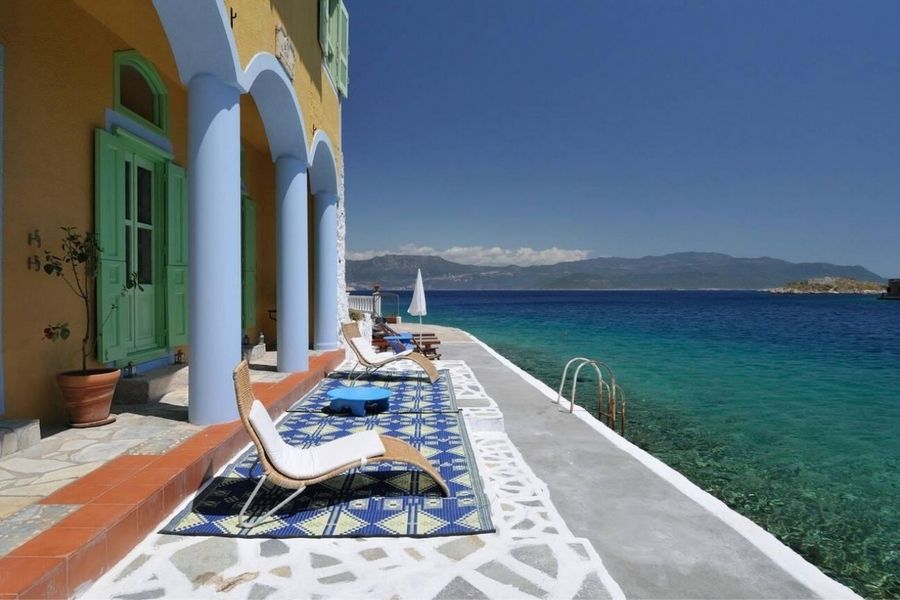
Accommodation Types:
- Traditional guesthouses (usually 5-10 rooms)
- Small hotels with harbor views
- Rooms in lovingly restored historic buildings
- Basic apartments for longer stays
If you’re coming in summer, book months ahead. Beds fill up fast between June and September.
Tips for a Memorable Visit
Pack light—trust me, lugging a huge suitcase here is more hassle than it’s worth. Essentials like sunscreen, meds, and anything you can’t live without should go in your bag.
Shopping is limited. There’s one small supermarket and a couple of shops for basics. The ATM works… until it doesn’t, so bring enough cash for your trip.
Essential Tips:
- Bring cash—cards aren’t accepted everywhere
- Pack any medications and toiletries you’ll need
- Double-check ferry times before planning your departure
- Reserve restaurants in advance during peak season
If you can, visit in spring or fall. The weather’s still great, but there are fewer crowds and better prices.
Frequently Asked Questions
Kastellorizo may be small, but it packs in a lot—quirky history, striking scenery, and a harbor that’s almost too pretty to be real. It’s so close to Turkey you can practically wave, and the logistics are part of the adventure.
What are the top attractions to visit in Kastellorizo?
The horseshoe-shaped harbor steals the show. Pastel buildings line the waterfront, packed with restaurants and bars.
The Blue Cave is the island’s wildest natural wonder. Inside, the water glows electric blue, and stalactites hang from the ceiling.
St George Beach gives you a beach club vibe on a tiny islet. Sunbeds and umbrellas go for 6 euros.
The Castle of the Knights of St John is worth the climb. Metal stairs take you up for sweeping views of Kastellorizo and Mandraki.
If you’re feeling energetic, the Monastery of Saint George is at the top of a 400-step staircase. The view from up there stretches across to Turkey.
How can one get to Kastellorizo and what are the transportation options available?
Olympic Air runs flights from Rhodes to Kastellorizo three times a week in low season, bumping up to six in high season. Flights take about 40 minutes.
Ferries also run from Rhodes. Dodekanisos Seaways gets you there in 2.5 hours, while Blue Star and SAOS ferries take a bit longer—3.5 to 5 hours.
Blue Star Ferries connects Athens’ Piraeus port to Kastellorizo twice a week. It’s a 22-hour trip with stops at other Dodecanese islands.
From Kaş, Turkey, ferries take only 20 minutes. Meis Express and Meis Ferry Lines operate daily from June to October.
What are the unique cultural experiences one can participate in on Kastellorizo?
There’s a strong Australian connection here. Many buildings are being restored thanks to “Kazzies”—Aussies whose families came from the island.
Local cats rule the harbor area. You’ll see them lounging in sunny spots or weaving between tables.
You might spot endangered loggerhead turtles swimming through the harbor. It’s always a thrill to catch a glimpse.
The folk art museum inside the old Ottoman mosque is worth a look. You’ll see traditional costumes and old photos that capture the island’s dramatic changes.
Are there any accommodation options on Kastellorizo that highlight the island’s charm?
The Poseidon Hotel spreads across eight brightly painted buildings. Studios, apartments, and villas come with kitchenettes and sea views.
Megisti is the island’s biggest hotel, a modern four-star spot at the western end of the harbor.
You’ll find several guesthouses scattered around town. Apartments and villas are also up for rent.
Most places to stay are on the western side of the harbor. Some hotels even set up sunbeds and umbrellas along the water for guests.
What local cuisine should one try when visiting Kastellorizo?
Waterfront restaurants serve up fresh seafood, with tables right over the water. The setting alone makes every meal feel special.
At St George Beach café, you can grab simple bites like burgers and club sandwiches. Just remember, it’s cash only.
Harbor bars offer drinks and light food all day. Many stay open into the evening—perfect for a nightcap.
Dining choices are limited, but what’s there is honest, local Greek food and plenty of fresh fish.
Can you provide information on the historical sites that are a must-see on Kastellorizo?
Let’s start with the 4th-century Lycian tomb. It’s carved right into the rock, and honestly, it’s a bit surreal to stand in front of something that old. You won’t find another tomb like this anywhere else in Greece.
Wander into the archaeological museum and you’ll spot pottery, statues, and weathered tombstones. They’ve set up the museum inside a wing of the old Castle of the Knights of St John, which adds to the atmosphere.
Speaking of the castle, this place actually gave Kastellorizo its name. The Knights called it “Castello Rosso,” or red castle, after those dramatic red cliffs that surround it. You can still see the ruins perched above the harbor, and the views are honestly worth the climb.
The Church of Saint George of Santrape stands out with its restored architecture. It’s a grand sight along the road between Kastellorizo and Mandraki, and stepping inside feels like a quiet escape from the island sun.
If you’re up for a little adventure, take a boat to the island of Ro. There you’ll find the grave of Despina Achladioti, the “Lady of Ro.” She became a legend for raising the Greek flag every day during the World War II occupation, and somehow, her story sticks with you long after you leave.

